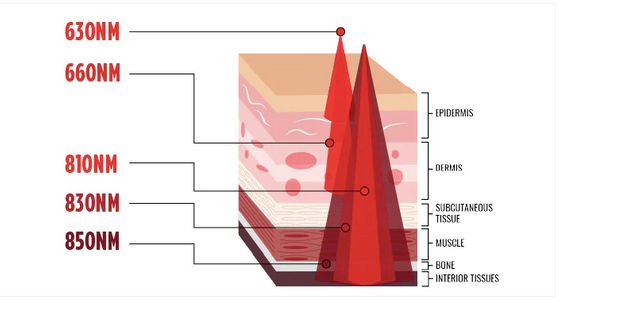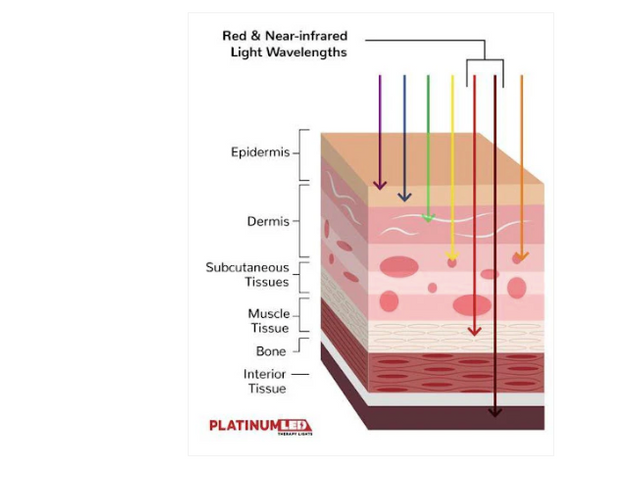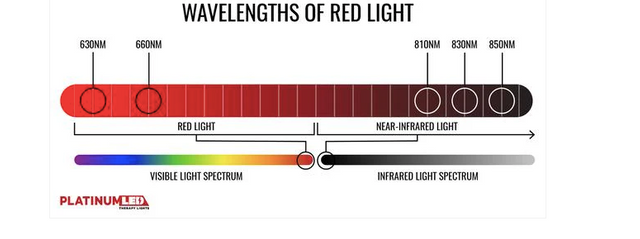Red Light Therapy what it is and what is known about it's host of alleged healing benefits.
Here’s what you need to know about these wavelengths: what they are, their benefits, when to use each one, and how they can work together to improve your health and wellbeing.
This article is for you if you’ve wondered:
What are infrared and near-infrared lights?
Red light therapy vs. infrared: Are they the same?
How do near-infrared and infrared therapy compare to red light?
Is one better than another?
When should I use red, infrared, or near-infrared light?
Also, note that Platinum Therapy Lights has added a 480nm blue light to all its BIOMAX Series panels for even greater holistic effects. Now, the panels also offer custom adjustment for each spectrum, meaning users can pick and choose which set of wavelengths to use as well as their intensity.
We look forward to seeing the increased benefits of this innovation in addition to the already effective red light wavelengths.
The Wavelengths of Red Light
The term 'red light therapy' often includes wavelengths in both the visible spectrum of light and the invisible spectrum of light. The visible spectrum is from 630 to 660 nanometers, whereas the invisible infrared spectrum is from 810 to 850 nanomeneters. This is considered near-infrared.
What all these wavelengths have in common is that they fall into what is known as the 'therapeutic window.' This means they have the power to treat specific conditions.
'Red light therapy' is also referred to as 'low-level light therapy' (LLLT) and 'photobiomodulation' (PBM).
Technically, both NIR and IR light therapy fall into the same category of invisible infrared wavelengths in the electromagnetic spectrum.
You may also see the acronym LLLT in reference to low-level laser therapy. In this treatment, the wavelengths and benefits are the same but the delivery is different. As the name implies, low-level laser therapy uses low-level lasers, whereas red light therapy utilizes red LED lights.
A large body of scientific research suggests wavelengths in the red/NIR electromagnetic scale can safely deliver a variety of health benefits, without adverse effects.
So what's the difference between the wavelengths?
In many respects, red, NIR, and IR wavelengths provide similar health benefits including pain relief as well as some surprising benefits like weight loss.
What sets red light apart from near-infrared is the depth to which the light photons can absorb into your body’s tissues.
NIR light is closely related to red light in that it doesn’t cause heating of the body, which occurs in wavelengths in the mid to far-infrared light spectrum.
NIR waves of up to 850nm are used in red light therapy systems. IR waves are most commonly used either in clinical applications or in infrared saunas.
Red Light Therapy vs. Near-Infrared
As you increase the wavelength of light, you also increase how deep the light penetrates into the body.
Red wavelengths benefit the skin and systems within the skin tissue, including the circulatory system, peripheral nervous system, and hair follicles.
The longer wavelengths of NIR light reach beneath the skin to cells deep in your body, including muscles, joints, and bones.
The Benefits of the Red Light Spectrum (630–660nm)
The visible red light spectrum primarily benefits skin conditions. It is best known for its anti-aging properties, such as fine lines and wrinkles, even skin tone, and photoaging, skin wound healing, stretch marks, and hair loss.
Example: Red Light for Skin Health
Multiple studies have shown the benefits of red light for skin health, and that it has no adverse effects.
A 2014 controlled trial showed promise for the use of red light to reduce wrinkles and increase collagen protein synthesis. You can see photos of the results in the red light therapy skin trial results.
Other potential health benefits of red light include:
Stimulating hair regrowth in both men and women
Reducing acne inflammation and breakouts
Reduction of fine lines, sagging skin, sun damage, and wrinkles
Psoriasis treatment
Healing of non-melanoma skin cancers
Accelerated wound healing
Reduction of inflammation due to pleurisy
Reduction of neuropathic pain (sciatic nerve pain)
Reduction of post-injury swelling and inflammation
Reduction of training fatigue and faster athletic recovery
Note: A powerful LED light therapy device will ensure the maximum possible penetration depth for any wavelength.
The Benefits of the Near-Infrared Spectrum (810–850nm)
As previously mentioned, NIR wavelengths from 810 to 850nm can penetrate deeper than red light, including connective tissue and bone. Most notably, these wavelengths can treat the brain.
Example: Near-Infrared Therapy for Brain Health
In a 2016 article, world-renowned red light expert Michael Hamblin discusses the exciting potential of red/NIR light therapy for treating myriad disorders of the brain.
He writes: “Many investigators believe that PBM for brain disorders will become one of the most important medical applications of light therapy in the coming years and decades.”
That is encouraging, although more studies are needed on the effects of NIR light and brain health. Anyone suffering from a brain injury or neurological disorder should always receive treatment as prescribed by a medical professional.
Other potential health benefits of NIR light include:
Improved muscle healing and accelerated recovery
Improved recovery from strokes
Improved recovery from neurological damage and from traumatic brain injury
Improvement of psychiatric disorders including anxiety and depression
Reduced recovery and accelerated healing following plastic surgery
Accelerated healing and reduced infection
Improved bone repair and growth
Accelerated return to athletic activity after injury
Nerve cells in particular appear to respond well to infrared light energy. Most studies reference infrared waves in the 800 to 900nm range.
Therefore, infrared light in the NIR spectrum could be a potentially effective therapy for Alzheimer’s, Parkinson’s, and other neurodegenerative disorders
Another potential use for NIR light is treating neuropathy. This is exciting news for those who suffer from diabetes or anyone who has nerve damage in their hands, feet, or other parts of the body.



Benefits of Infrared Therapy (900+nm)
Beyond 850nm, infrared waves penetrate even deeper. Infrared light therapy is most commonly used in infrared saunas, which typically use wavelengths in the 1000nm range.
What’s really interesting is that the human body reacts differently to these longer wavelengths. Instead of light, the body perceives them as infrared heat.
When infrared waves come in contact with your body’s tissues, it causes the molecules to vibrate, which produces heat and causes a rise in body temperature.
This infrared heat effect can stimulate local blood circulation and reduce muscle tension. This is one of the reasons infrared saunas have become so popular worldwide.
Used with caution, infrared therapy is seen as a potentially effective treatment for:
Pain relief
Cancer, when used as photoimmunotherapy
Reducing the side effects of chemotherapy
Accelerating healing of the brain after injury
We recommend that potential users of infrared saunas also check with their doctor before seeking treatment.
Infrared light therapy (over 900nm) has the deepest penetration along with positive health effects, but should be used with caution to prevent thermal damage to the body’s cells.
Light therapy is exposure to light that is brighter than indoor light and is used to help with cognitive abilities that may suffer due to depression, seasonal affective disorder, or sleep disorders. If you have ever heard of a “light box,” or if you have one in your home, this is a form of light therapy. Exposing people to light for 30 minutes to a few hours a day can help stimulate a change in the levels of chemicals and hormones within the body that affects mood. Our body uses light cues to time certain functions such as sleeping, waking up and so on. How we sleep, how active we are and how we feel are regulated by our internal body clock. If ours is off, our energy levels, ability to sleep and mood is affected! This is where light therapy can come in handy.
Light therapy is on the visible part of the light spectrum (between 400 nm to 480 nm). Though slightly different from color light therapy, light therapy can help to regulate sleep patterns, improve mood, increase cognitive performance and regulate hormones.
Red Light vs. Near Infrared Therapy
Red light therapy and near infrared light therapy fall into a whole other light spectrum. The two are often confused as the same thing but they are really quite different. Red light falls into the visible part of the light spectrum between 630-700 nm on the electromagnetic scale and is used to treat the surface of the skin. Near infrared wavelengths fall into the invisible part of the light spectrum between 700 and 1200 nm. So what does this mean? The longer the wavelength, the deeper the penetration to deliver energy to the cells, stimulating healing and relieving pain. Various cell and tissue types each have their own unique light absorption methods at varying wavelengths. This means certain tissues absorb certain kinds of light. For example, light vibrating at the blue wavelength is great for skin while other colors may penetrate the skin more deeply – see LEDs in Dermatology study.
The optimal NIR technology is done by LED as you are able to control the surface temperature. Also LED disperses over a larger surface area than a RED light halogen or laser. Another major difference between LED and halogen and Laser is the way light energy is delivered (optical power output – OPD). The OPD of LED Near is measured in milliwatts and laser and halogen is measured in watts. This allows LED to have a more gentler delivery as it will not damage tissue and will not have the same risk of accidental eye injury. Also with LED NIR disperses over a greater surface area give a faster treatment time.
NASA research has found that the NIR electromagnetic frequency band of energy penetrates deeply into the body and can have a healing effect on our individual cells. For example, inside the mitochondria of every cell are receptors which respond to Near Infrared wavelengths. The light triggers an increase in cell metabolism, protein synthesis (including collagen), and anti-oxidant activity (meaning the cells detoxify). Additionally, it reduces inflammation and pain while simultaneously triggering growth and regeneration in the cells.
In short, light therapy affects mood, circadian rhythm and other body processes, while Near Infrared Therapy acts a pain reliever and cell rejuvenator – two VERY different forms of energy, but both beneficial.
Benefits of Near Infrared Therapy
Near Infrared Therapy falls on the spectrum of Infrared Light which is barely visible to the eye and is also the shortest infrared wavelength on the electromagnetic spectrum. Infrared typically includes wavelengths from 700 nm to 1 mm. Near Infrared light, however, falls in the spectrum of 700 nm to 2500 nm.
Boosts metabolism
Recharges mitochondria
Stimulates white blood cell production
Reduces body fat
Promotes cell regeneration
Increases energy
Reduces inflammation within the body
Improves circulation within the body
Heals wounds faster
Faster recovery time after working out
Provides pain relief
Rejuvenates the skin
Lessens joint and muscle pain
Improves flexibility
Provides anti-aging benefits to your body
#LIghtThereapy, #RedLightTherapy, #NearInfraredLight, #NearInfraredRedLight, #LightSpectrum, #Holistic, #Healing
Sources
https://platinumtherapylights.com/blogs/news/red-vs-infrared-and-nir-light-therapy
https://www.degreewellness.com/2019/06/the-difference-between-light-therapy-and-near-infrared-therapy/
https://www.reddit.com/r/redlighttherapy/comments/12srqm9/red_light_therapy_vs_nearinfrared_vs_far_infrared/
https://nutritionaltherapy.com/cellular-detoxification-and-regeneration-through-incandescent-sauna-therapy/